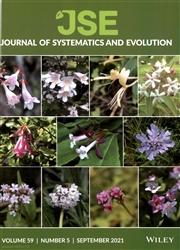Areas of endemism of the orchids of Megamexico: Hotspots of biotic interactions with pollinators
IF 2.9
1区 生物学
Q1 Agricultural and Biological Sciences
引用次数: 0
Abstract
Ecological interactions and evolutionary processes in areas of endemism remain little studied despite the fact that identifying the patterns of functional signatures in areas of endemism could reveal important information regarding community assembly and functioning. Here, we investigated whether areas of endemism of the orchids of Megamexico are hotspots of biotic interactions by comparing the orchid–pollinator interactions with those of adjacent areas. Patterns of functional signatures and phylogenetic signal were estimated, using pollination syndromes as a proxy for functional attributes. Phylogenetic signal was estimated by coding pollinator groups for every orchid recorded. Metrics of the interaction networks and the phylogenetic signal were compared with those obtained from adjacent areas. Our results indicate that areas of endemism show higher significant differences in the phylogenetic signal compared with adjacent areas. This can be explained by the many distantly related orchid lineages sharing attributes related to pollination. Network size and robustness differed statistically between the areas of endemism and the adjacent areas. The same configuration of modules in interaction networks was found in the areas of endemism; however, remarkably, the composition of species in large genera differed in these areas. Areas of endemism harbor more orchid lineages that closely interact with many groups of insects. The southerly areas of endemism in Chiapas and Central America are prominent, with the most significant phylogenetic signal and networks metrics. Results indicate that areas of endemism for the orchids of Megamexico represent hotspots of biotic interactions. Strategies for conservation must take this biotic interaction into account.大墨西哥地区兰花的特有区域:生物与传粉媒介相互作用的热点地区
尽管确定特有地区的功能特征模式可以揭示有关群落组合和功能的重要信息,但对特有地区的生态相互作用和进化过程的研究仍然很少。在这里,我们通过比较兰花与传粉昆虫之间的相互作用以及邻近地区的兰花与传粉昆虫之间的相互作用,研究了梅加美墨西哥兰花特有地区是否是生物相互作用的热点地区。我们使用授粉综合征作为功能属性的代表,估算了功能特征模式和系统发育信号。通过对记录的每种兰花的授粉者群体进行编码,估算系统发育信号。相互作用网络和系统发育信号的度量指标与邻近地区获得的指标进行了比较。我们的研究结果表明,与邻近地区相比,特有地区的系统发生学信号显示出更大的显著差异。这可能是由于许多关系较远的兰花品系共享与授粉相关的属性。在统计意义上,特有地区和邻近地区的网络规模和稳健性存在差异。在特有地区,相互作用网络中的模块配置相同;但值得注意的是,在这些地区,大属中的物种组成不同。地方特有地区有更多的兰科植物,它们与许多昆虫类群有着密切的相互作用。恰帕斯州和中美洲南部的特有性地区最为突出,其系统发生学信号和网络度量最为显著。研究结果表明,大墨西哥地区的兰花特有区域是生物相互作用的热点地区。保护战略必须考虑到这种生物相互作用。
本文章由计算机程序翻译,如有差异,请以英文原文为准。
求助全文
约1分钟内获得全文
求助全文
来源期刊

Journal of Systematics and Evolution
Agricultural and Biological Sciences-Ecology, Evolution, Behavior and Systematics
CiteScore
7.40
自引率
8.10%
发文量
1368
审稿时长
6-12 weeks
期刊介绍:
Journal of Systematics and Evolution (JSE, since 2008; formerly Acta Phytotaxonomica Sinica) is a plant-based international journal newly dedicated to the description and understanding of the biological diversity. It covers: description of new taxa, monographic revision, phylogenetics, molecular evolution and genome evolution, evolutionary developmental biology, evolutionary ecology, population biology, conservation biology, biogeography, paleobiology, evolutionary theories, and related subjects.
 求助内容:
求助内容: 应助结果提醒方式:
应助结果提醒方式:


